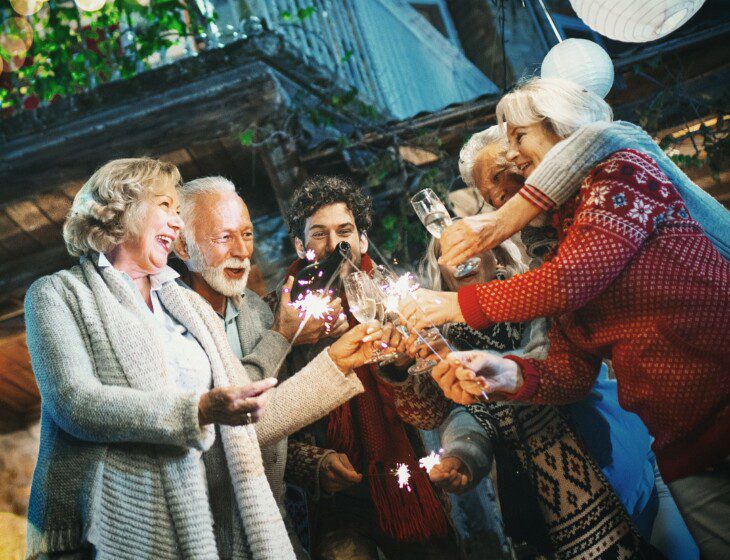Who doesn’t love the idea of casting off the old year and starting with a fresh slate? Americans certainly do, as 41% of us list New Year’s Eve as our favorite holiday. However, the ways we celebrate the holiday today have changed a lot over the centuries. Even the time of year that many of us in North America use to mark the New Year is rather recent, as historical markers go.
Here’s a look back at the origins of some of the more popular traditions.
Why We Celebrate the New Year
People have celebrated the New Year since at least the time of ancient Babylon over 4,000 years ago. The day was usually celebrated on the vernal equinox in late march. This changed in 46 B.C. due to the introduction of the Julian calendar by Roman Emperor Julius Caesar.
Caesar reformed the prior calendar so that it would once again sync up with the sun’s passage, leading to the shift of New Year’s day from late spring to January 1. The modern Gregorian calendar, which many of us in North America use today, continued this tradition.
You may be surprised to learn that some of our more cherished traditions related to this holiday go back to the Babylonian period, too. Many more are relatively recent additions.
The Most Popular New Year’s Traditions
There are numerous regional and cultural ways to celebrate the New Year. Some of us mark the occasion with families and friends, fireworks displays, or enjoying a night out on the town.
Here are the most popular New Year’s traditions, and where they came from:
- The champagne toast. Toasting in the New Year with a glass of bubbly is a tradition that only dates back to the 19th century. During this period, bottled drinks became more affordable due to advances in technology. However, purchasing champagne was still considered an extravagance by many. That’s why the champagne industry invested big in promoting champagne as the go-to beverage for special occasions. The push worked, and today it’s estimated that we enjoy over 360 million glasses of champagne on New Year’s Eve.
- Fireworks displays. The origin of marking the new year with fireworks dates back to China, where the impressive and colorful displays were first manufactured. It’s believed that the sound of the fireworks scares off both evil spirits and misfortune.
- The ball drop. The tradition of setting off fireworks on New Year’s also led to the creation of the iconic “ball drop” in Times Square. The first New Year’s Eve celebration in Times Square in 1904 featured fireworks, but New York City banned fireworks just two years later. With no fireworks to mark the occasion, how could event organizers draw crowds downtown? Enter the 700-pound iron and wood ball that inches its way down the pole until midnight.
- Midnight kiss. If you enjoy ringing in the New Year with a kiss, you’re participating in a tradition that’s been traced back to England and Germany, where kissing at the stroke of midnight was believed to bring new luck in the year ahead.
- New Year’s resolutions. The Babylonians renewed oaths to their king during the new year, which may be how the idea of the new year as a time of recommitment began. Early Christians made some of the first New Year’s resolutions, resolving to re-commit themselves to the tenets of their faith. Making resolutions has since become a mostly secular tradition, and a perennial subject of thought and discussion.
How to Make Healthy New Year’s Traditions
While many of us associate the New Year with parties and spectacle, that doesn’t mean you should feel obligated to spend it this way. In fact, there’s one New Year’s tradition that you can engage in that will help you live longer” making New Year’s resolutions!
So try incorporating these healthier traditions (or resolving to!) in your own New Year’s celebration this year:
- Make healthy food choices. When planning your holiday party or outing, focus on eating more whole foods, such as fruits and vegetables. Diets rich in foods such as whole grains, legumes, fish, healthy fats and of course fruits and vegetables have been shown to improve cardiovascular health.
- Get more sleep. Did you know that older adults need just as much sleep as younger adults? Nearly 30% of those celebrating the New Year are in bed before midnight. Make it a habit!
- Drink moderately. Enjoying a glass of champagne on New Year’s can be made healthier by choosing a small glass. This can help limit the amount you drink and lead to much more restful sleep.
- Celebrate by participating in a physical activity you enjoy. Consider spending the New Year doing something active, such as dancing, skating, or even just enjoying a stroll with someone you love.
- Make a plan for the coming year. Most of us make resolutions this time of year, but few of us actually keep them. Get into the habit of creating a plan that will help you achieve your resolutions.
Start the New Year at Friendship Village of Bloomington
Friendship Village of Bloomington is a warm, inviting and engaging senior living community in Bloomington, Minnesota. If you’re considering a move to a community like ours this year, we invite you to join us for a tour, or explore our exceptional suite of amenities and services. Our residents were once just like you, nervous but excited for the changes ahead. Now they enjoy all the benefits and personal serenity of knowing their needs are cared for today and every day forward. Contact us to learn more about what makes our community such a special place to live.


